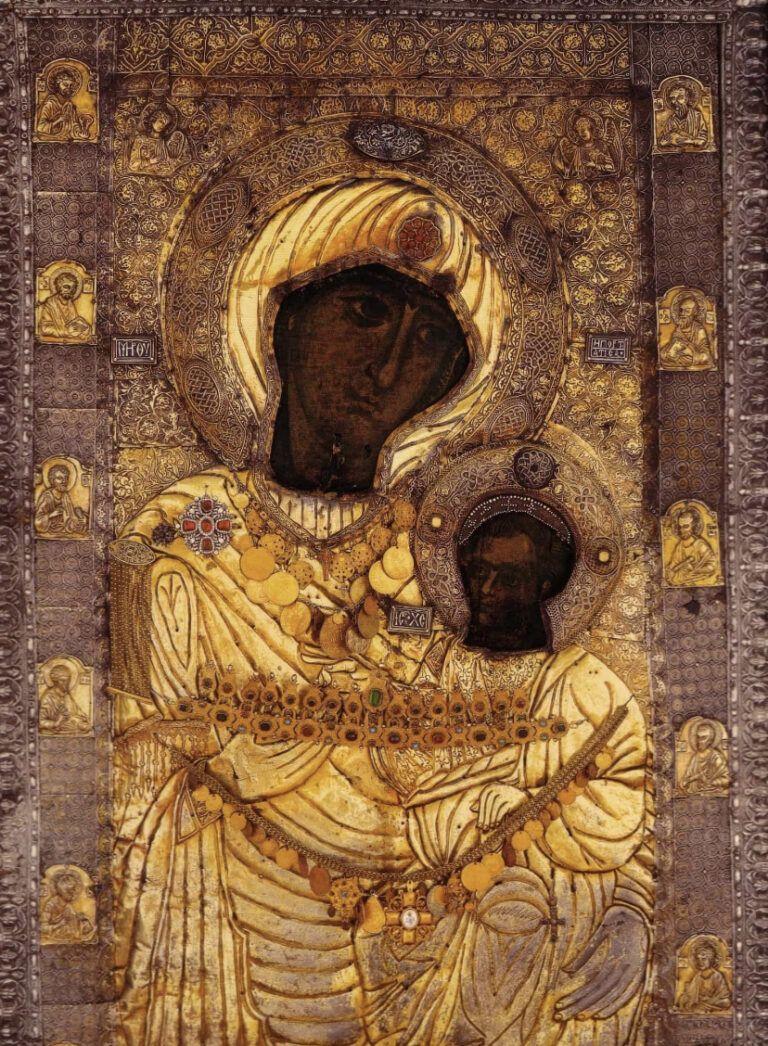
Panagia Portaitissa do Monastério Iviron – Monte Athos
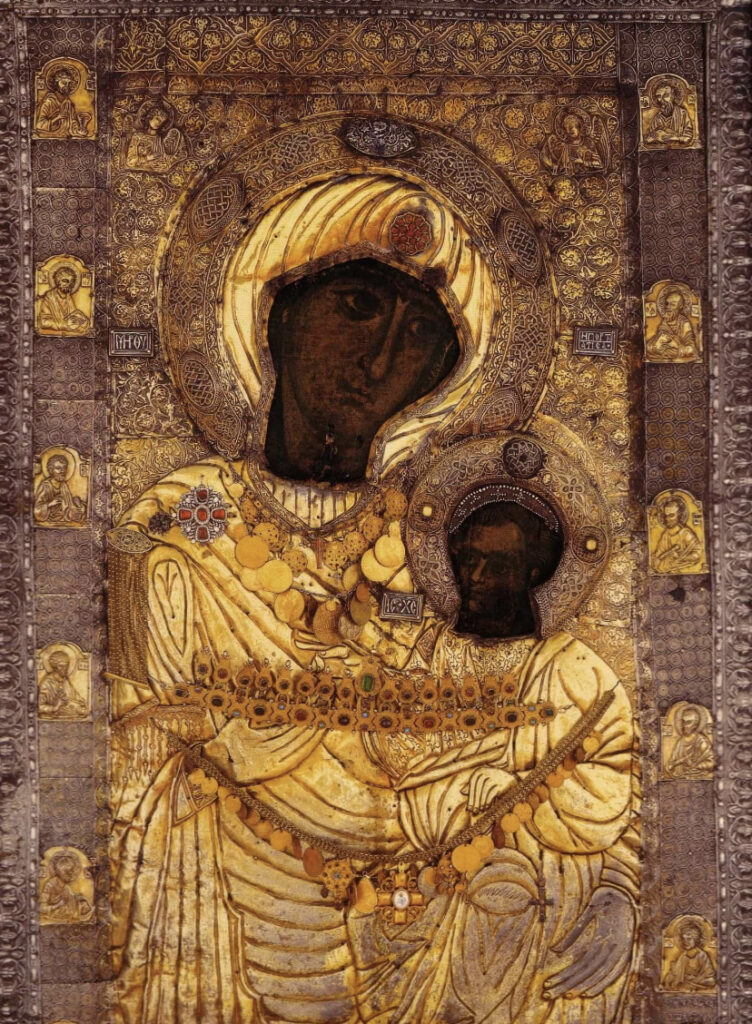
Assista os filmes sobre o ícone Panagia Portaitissa:
Panagia Portaitissa, o ícone que voou e é o Guardião do Monte Athos e do Monastério Iviron
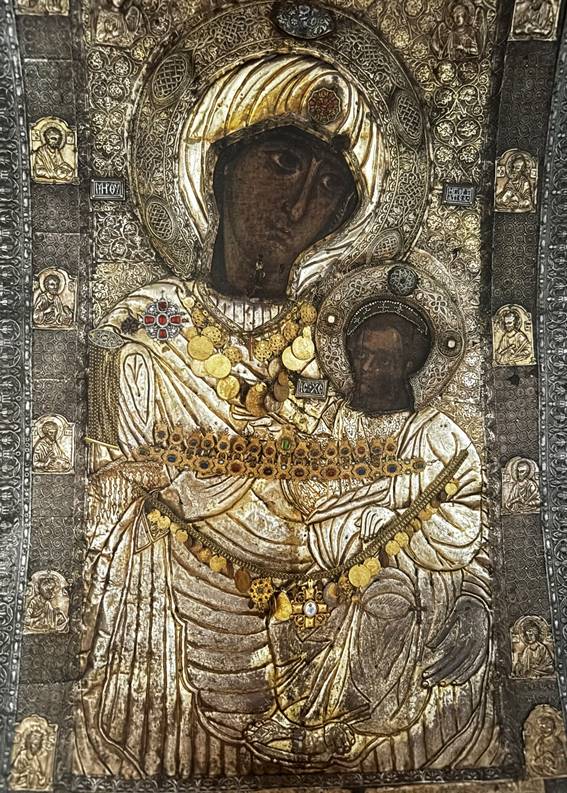
Panagia Portaitissa – Monastério Iviron – Monte Athos/Grécia
“Senhora Protetora, nossa Rainha e Theotokos”.
“Nós, teus servos, trazemos-te hinos de louvor; nós que te recebemos como uma arma forte, uma parede inabalável e uma proteção invencível.
Cubra-nos e proteja-nos de todos os inimigos visíveis e invisíveis, e das feridas da alma e do corpo, para que possamos clamar a você:
“Alegra-te, abençoada Portaitissa,
Você que abre as portas do Céu aos fiéis!”
O ícone Portaitissa teria sido pintado em Jerusalém pelo próprio apóstolo Lucas e fica junto à antiga entrada, onde se encontra a capela de Theotokos Portaitissa (a Porteira) com o ícone milagroso homônimo de Theotokos.
O ícone é levado ao Catholicon apenas nas grandes festas e é levado em procissão na Terça-feira da Renovação.
Os afrescos do nártex datam de 1774 e retratam sábios e reis da antiguidade.
Além disso, a poucos passos do mosteiro, à beira-mar, encontra-se a fonte de Água Benta de Theotokos Portaitissa, onde foi encontrado o seu ícone.
Theotokos Portaitissa, a guardiã do Monte Athos, o famoso ícone milagroso da Virgem Maria do século IX, está localizada no Monastério Iviron.
A tradição do Monte Athos conecta o ícone com o período da iconoclastia bizantina sob o imperador Teófilo (829-842).
Em Nicéia, os soldados do imperador queriam tirar o ícone de uma viúva e pediram um suborno.
A Mulher orou e pediu iluminação para salvar o ícone.
A mulher o levou para a beira do mar, e este saiu voando e desapareceu no horizonte.
O único filho da viúva tornou-se monge, veio para o Monte Athos e passou a vida no mosteiro de Iviron.
Ele contou a história do ícone aos seus companheiros monges.
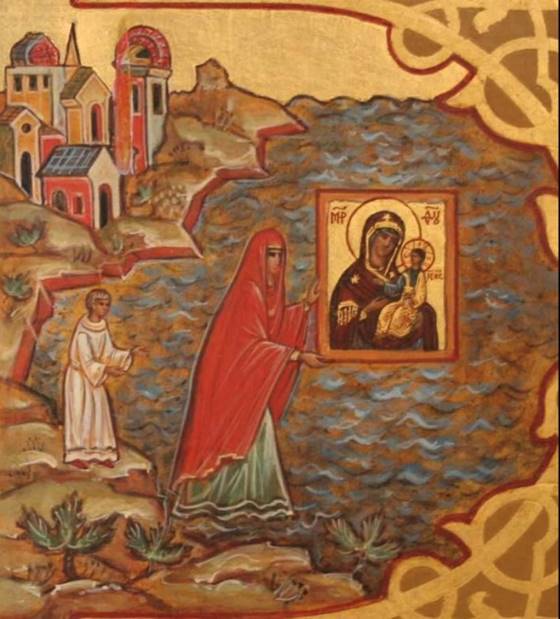
A Piedosa Vitória enviando o ícone Portaitissa para o Monte Athos – Fonte: Icons of Panagia – Episode 1: Panagia Portaitissa & Panagia Paramythia do Canal do Youtube Greek Orthodox Christian Society Sydney
O ícone estava na casa de uma mulher piedosa (Vitória) com seu único filho que o louvavam em sua capela particular.
Espiões do Imperador descobriram o ícone e pediram um suborno para não o queimar e por isso a piedosa mulher orou ao ícone e pediu iluminação sobre o que fazer para que este não sofresse a fúria dos perseguidores de ícones.
Foi quando Vitória foi iluminada para ir à praia e soltar o ícone para que este viajasse para a Grécia.
A mulher disse: “Theotokos, Mãe de Deus, você tem o poder de nos salvar das tramas do rei e tem também o poder de salvar sua imagem da mão dos inquisidores! Vá para a Grécia!”.
Nisto, o ícone saltou sobre as ondas e a mãe se voltou para seu filho ainda menino, e disse:
“Vou Morrer de amor logo por Theotokos! Voe para a Grécia e o quanto antes!”
Este seguiu os conselhos e fundou o monasticismo no Monastério de Iviron anos mais tarde.
E isto foi uma providência divina, pois foi desta forma que os monges já tinham conhecimento da existência deste santo ícone, que a tradição monástica atribui ter sido pintado pelo próprio apóstolo Lucas.

Panagia Portaitissa – chegada milagrosa do ícone flutuando pelo mar ao Monastério Iviron do Monte Athos – Icons of Panagia – Episode 1: Panagia Portaitissa & Panagia Paramythia do Canal do Youtube Greek Orthodox Christian Society Sydney
Certa vez, anos depois da morte do monge filho da mulher piedosa de Nicéia, o ícone apareceu na margem do porto do mosteiro e foi obtido pelo mais humilde monge de Iviron, Gabriel.
Era noite quando os monges ouviram um estranho sinal.
Uma pilha de fogo nascia no mar e atingia os céus.
E este fogo apareceu por vários dias até que os monges foram até a beira mar e viram extasiados o ícone maravilhoso na base do pilar de fogo que não se apagava.
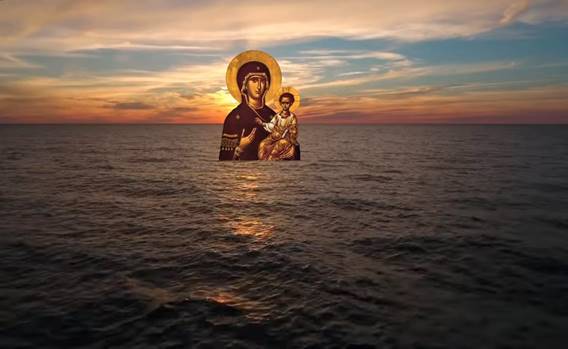
Ícone da Panagia Portaitissa ou Panagia Paramythia brilhando no mar – Fonte: Icons of Panagia – Episode 1: Panagia Portaitissa & Panagia Paramythia do Canal do Youtube Greek Orthodox Christian Society Sydney
Porém, o ícone não permitiu que os monges o pegassem e estes se reuniram na igreja orando pedindo instruções a Virgem e o favor de receberem este grande tesouro no Monastério.
Até que a própria Panagia apareceu ao monge Gabriel e disse:
“Fale para os frades e abades que Eu vou dar o meu ícone para proteger o Monastério. Você vai entrar no mar e andar sobre as ondas e pegá-lo.
Assim todos saberão de meus favores pelo Monastério.”
E assim ocorreu. O monge Gabriel andou nas águas e trouxe o ícone para o Monastério e este foi recebido com grandes honras em procissão e foi posto no Catholicon.
No dia seguinte, o ícone tinha reaparecido em cima dos portões de entrada do monastério.
Trazido de volta pelos monges, novamente o ícone se auto deslocou e reapareceu nos portões e assim por diversas vezes.
Finalmente, Panagia apareceu novamente para o monge Gabriel e lhe disse:
“Fale para os irmãos não mais me importunarem.
Eu não vim aqui para me proteger de vocês, eu vim aqui para proteger vocês.
Em especial aos que vivem virtuosamente esperando com esperança a misericórdia de meu Filho.
Porque, enquanto a minha imagem estiver aqui, a divina graça e a misericórdia de meu Filho estarão sempre sobre vocês.”
Após isto os monges construíram uma capela na porta do monastério. Por isso, o ícone é chamado de Panagia Portaitissa!
Certa vez, um pirata árabe que invadiu o mosteiro atingiu o ícone com sua faca e o sangue começou a fluir do ícone, que mostra Panagia com cicatriz e sangrando.
O pirata se arrependeu, tornou-se cristão fervoroso, virou santo e recebeu o nome de Agios Varvaros (São Bárbaro) e sua pintura pode ser encontrada na parede da capela.
A memória do Santo Bárbaro é celebrada dia 21 de maio.
“Em outra ocasião, Maria Divina apareceu em sonho para um antigo monge chamado Gabriel e lhe disse:
“Informe a população e os monges para prestarem ao ícone uma adoração, e obterão a minha proteção.
Vão até o mar e caminhem com fé, e então eu vou mostrar todo o meu amor por seu monastério”.
Então os monges foram para a costa, em hinos de súplicas, e adoraram a imagem de Maria por diversos dias e noites.
Até que um dia Maria apareceu novamente para o velho Gabriel e lhe disse:
“Diga a seus irmãos que Eu não quero ser como Deus, eu quero ser como vossa guardiã nesta vida e na próxima.
Peça por uma graça sagrada de Deus e enquanto tiverem o ícone no monastério e estiverem performando boas obras, a graça de meu filho nunca lhes abandonará.”
Esta história estará contada em detalhes adiante neste livro quando tratar do ícone Panagia Portaitissa.
Fonte: DVD Miraculous Icons of the Blessed Mother in Athos – Panagiotis Tsatsanidis.
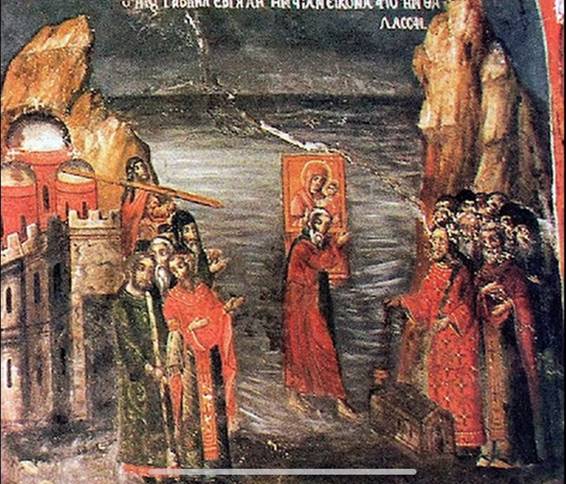
Ícone da Panagia Portaitissa sendo resgatado pelo monge Gabriel no mar – Fonte: Icons of Panagia – Episode 1: Panagia Portaitissa & Panagia Paramythia do Canal do Youtube Greek Orthodox Christian Society Sydney
Durante a iconoclastia bizantina (séculos VIII-IX dC), muitos ícones foram tidos como formas de idolatria e foram jogados ao mar pelos fiéis para serem salvos dos iconoclastas.
A providência de Deus os levou a lugares onde foram protegidos e reverenciados.
Quando a mulher piedosa de Nicéia decidiu jogar ao mar seu ícone de Theotokos Portaitissa; ela lamentou e lamentou a perda de seu amado ícone, mas a Santíssima Theotokos deu-lhe conforto durante seu sono e disse-lhe que enviaria o ícone para um lugar onde muitas nações e línguas o adorariam durante séculos.
Muitos anos depois, em 1004, o ícone apareceu sobre o mar em frente ao mosteiro de Iviron, flutuando verticalmente sobre as águas com fogo.
Os monges ficaram maravilhados e tentaram tirar o ícone do mar, mas um poder invisível os impediu.
Foram ao mosteiro e rezaram pedindo iluminação sobre como poderiam pegar o ícone, sendo que este tinha fugido deles.
A pouca distância do mosteiro, vivia na serra o monge Gabriel.
Theotokos apareceu-lhe e disse-lhe: “Quero que venhas trazer o meu ícone do mar, porque é a ti que considero o direito de carregá-lo para o mosteiro”.
O anacoreta obedeceu e desceu para pegar o ícone.
Mas quando entrou no mar, para surpresa de todos, não afundou, mas caminhou sobre as águas, como se fosse terra firme, até trazer o ícone para a areia.
No local onde o ícone ficou pela primeira vez depois de sair do mar, jorrou água benta de uma fonte que jorra até hoje.

Panagia Portaitissa – protegendo o Monastério Iviron – Fonte: Icons of Panagia – Episode 1: Panagia Portaitissa & Panagia Paramythia do Canal do Youtube Greek Orthodox Christian Society Sydney
O monge Gabriel, o abade e os monges, transferiram o ícone para o Catholicon e o instalaram em local de destaque.
Mas no dia seguinte não o encontraram dentro da igreja, mas por cima do portão.
Isso foi repetido várias vezes e os monges perceberam que Theotokos queria ficar perto do portão.
Neste momento, ela apareceu ao abade e disse-lhe:
“Vim aqui para te proteger, não para ser guardada”.
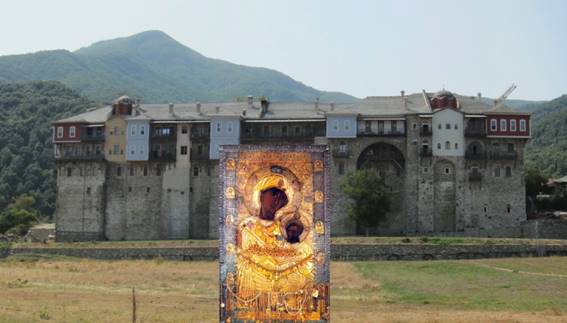
Panagia Portaitissa na frente do Monatério Iviron – Fonte: Icons of Panagia – Episode 1: Panagia Portaitissa & Panagia Paramythia do Canal do Youtube Greek Orthodox Christian Society Sydney
Depois disso, construíram uma bela capela ao lado do portão e ali foi colocado o ícone, onde permanece até hoje como guarda, médica e protetora de todos os monges do Monte Athos.
Daí o nome do ícone “Gatekeeper”.
Uma tradição atônita diz que, se o ícone de Portaitissa sair do Monte Athos, os monges também deverão partir.
De acordo com São Nilos, o jorro de mirra de Athos, quando a ilegalidade se multiplicar, o ícone partirá do Monte Athos.
Há uma cicatriz na face da Santíssima Theotokos.
Um pirata selvagem esfaqueou o ícone sagrado aqui e o sangue correu.
Mas então o bárbaro se arrependeu e tornou-se monge e fiel servo da Theotokos neste mosteiro.
Além disso, em vez do novo nome que lhe foi dado, ele gostou mais do nome Bárbaros (ou seja, bárbaro).
Este monge atingiu o ápice da virtude e hoje a Igreja Ortodoxa comemora São Bárbaro, de Iviron, no dia 13 de maio.
Em 1651, 365 monges do Iviron enfrentavam dificuldades financeiras; portanto, eles confiaram à Theotokos a tarefa de cuidar de sua subsistência.
Logo depois, a carinhosa Mãe se apressou em buscar seu sustento, fazendo uma maravilha relatada adiante.
Naquela época, a filha do czar russo, Aleksey Mikhailovich Romanov, estava gravemente doente.
Mas a dor dela e de seus pais reais foi transformada em alegria pela milagrosa Portaitissa.
A donzela paralisada recuperou-se e o czar, expressando a sua gratidão, cedeu um dos maiores mosteiros da capital russa, São Nicolau, ao Iviron.
Esta propriedade permaneceu na propriedade de Iviron até 1932, gerando tantas receitas que quase atendia a todas as suas necessidades materiais.
É por isso que os russos estão ligados à Theotokos Portaitissa até hoje, cuja memória é celebrada no dia 12 de fevereiro, assim como do monge que a resgatou no mar, Gabriel, que foi conhecido como monge Gabriel, o ibérico.
São João de Damasco (citado no filme Icons of Panagia – Episode 1: Panagia Portaitissa & Panagia Paramythia do Canal do Youtube Greek Orthodox Christian Society Sydney) afirmou:
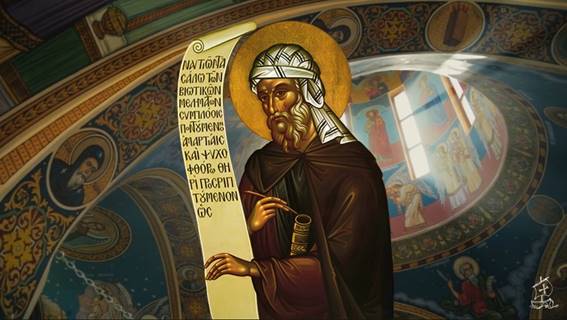
São João de Damasco – Fonte: Icons of Panagia – Episode 1: Panagia Portaitissa & Panagia Paramythia do Canal do Youtube Greek Orthodox Christian Society Sydney)
“Quando veneramos os ícones, não honramos a madeira destes, mas as pessoas representadas nos ícones!
Este é o caso claro de Panagia, que é honrada com diversos ícones que a representamos.
Porém, nossa veneração deve ir além dos aspectos físicos da veneração, devemos nos prostrar diante do ícone e beijá-lo!
Devemos viver em estado de verdadeira veneração.”

Panagia Portaitissa – pintura do ícone antes do milagre – Monastério Vatopedi – Foto tirada pelo autor

Mural de Panagia Portaitissa – Monastério Vatopedi – Foto do autor
Certa vez, os monges, ao saírem da igreja para entregar as chaves do mosteiro ao porteiro ouviram o ícone dizer:
“Não abram as portas do mosteiro. Os piratas vão atacar, subam as montanhas e fujam dos ladrões”.
A voz repetiu o que tinha dito com voz mais severa. Ao girar os olhos, o abade viu a Criança Divina estender o braço querendo cobrir a boca de sua mãe, e dizer com voz doce:
“Não proteja, mãe, esses rebanhos pecaminosos. Deixe-os sucumbir sob a espada dos piratas; porque seus erros são inumeráveis.”
Mas a Virgem, segurando a mão de Jesus e virando a cabeça um pouco, repetiu o aviso.
“Não abram as portas do mosteiro.
Os piratas vão atacar, subam as montanhas e fujam dos ladrões.
E se arrependam de seus pecados, pois meu Filho está bravo com vocês!”.
Foi quando o monge percebeu que Jesus e Maria estavam vivos no ícone, que ficou totalmente modificado após esta aparição maravilhosa.
A posição de Maria e Jesus mudaram totalmente para a contemplação dos monges, que correram rapidamente para as muralhas e descobriram que piratas estavam esperando a porta ser aberta para saquear e matar.
Mas o convento foi salvo graças à intervenção milagrosa da Virgem e do menino Jesus.
Desde então, os monges mantem acesa uma lamparina à frente do ícone, o celebram às sextas-feiras e cantam uma oração todos os dias.
O ícone é também chamado de Ktitorissa, porque sua descoberta coincidiu com o tempo dos três fundadores (Ktitores em grego) do convento, Atanásio, Nicolau e Antônio.
Em comemoração até mesmo deste milagre, um cânon é cantado à Santíssima Mãe de Deus toda segunda-feira, e uma missa é celebrada toda terça-feira no Catholicon.
Este milagre é idêntico ao promovido pelo ícone Panagia Paramythia do Monastério Vatopedi, indicando que a Santíssima Virgem salvou os monges de mais de um mosteiro dos ataques de piratas.
Panagia Portaitissa at Iviron Monastery
The Panagia Portaitissa also known as the Iviron Theotokos or Iverskaya in Russian, is an Eastern Orthodox icon of the Virgin Mary in the Georgian Iviron monastery on Mount Athos in Greece, where it is believed to have been since the year 999.
According to the sacred tradition of the Eastern Orthodox Church it was painted by Luke the Evangelist. The icon is referred to as “Wonderworking” meaning that numerous miracles have been attributed to the intercession of the Theotokos (Mother of God) by persons praying before it.
The synaxis (feast day) for this icon is on February 12, as well as on Bright Tuesday, and also on October 13 for the translation to Moscow of the Iveron icon.
The icon belongs to a family of images of the Theotokos known as Hodegetria (Greek: Όδηγήτρια, “she who leads the way”) after the prototype from Constantinople. In these icons, the Christ Child sits on his mother’s left arm and she is depicted pointing to Christ with her right hand. Another famous icon based upon Hodegetria is Our Lady of Częstochowa.
A unique characteristic of this icon is what appears to be a scar on the Virgin Mary’s right cheek or her chin.
A number of different traditions exist to explain this, but the one most commonly held by Orthodox Christians is that the icon was stabbed by a soldier in Nicaea during the period of Byzantine iconoclasm under the Emperor Theophilus (829–842). According to tradition, when the icon was stabbed, blood miraculously flowed out of the wound.
The original in Iveron is encased in a chased riza of silver and gold covering almost all the figures except the faces, as is common with the most venerated icons.
According to the Orthodox Church’s sacred tradition, the icon was at one time in the possession of a widow in Nicaea.
Not wanting the icon to be seized and destroyed by the iconoclasts, she spent all night in prayer and then cast the icon into the Mediterranean Sea.
The widow’s son later went to Mount Athos, where he became a monk and recounted the miracle of the bleeding wound, and how the icon had been placed in the sea.
Much later (c. 1004) the icon was recovered from the sea by a Georgian monk named Gabriel the Iberian (later canonized a saint in the Orthodox Church), who was laboring at the Iveron Monastery on Mount Athos.
This occurred on Tuesday of Bright Week (Easter Week), and is commemorated annually on that day (as well as the fixed date of March 31). The icon was taken to the katholikon (main church) of the monastery from which the icon gets its name.
The tradition goes on to say that the following day, when the monks entered the church they could not find the icon. After searching they discovered the icon hanging on the gates of the monastery.
This occurrence was repeated several times, until St. Gabriel reported that he had seen a vision of the Theotokos, wherein she revealed that she did not want her icon to be guarded by the monks, but rather she intended to be their Protectress.
After this, the icon was permanently installed above the monastery gates, where it remains to this day.
Because of this, the icon came to be called Portaitissa or “Gate-Keeper”.
This title was not new for the Virgin Mary, but comes from a verse of the Akathist to the Mother of God:
Orthodox monks and nuns throughout the world will often place an icon of the Theotokos Iverskaya on the monastery gates.
It is also common in Orthodox temples (church buildings) to place an icon of the Theotokos Portaitissa on the inside of the iconostasis, above the Holy Doors, looking towards the Holy Table (altar table).
Moscow version
In1648, Patriarch Nikon of Moscow, while he was still Archimandrite of Novospassky Monastery, commissioned an exact copy of the Iviron icon to be made and sent to Russia. Almost immediately upon its arrival on October 13, the icon was “glorified” with numerous miracles attributed to it by the faithful.
The Iverskaya Chapel was built in 1669 to enshrine the icon next to the Kremlin walls in Moscow.
The chapel was the main entrance to Red Square and traditionally everyone, from the Tsar down to the lowest peasant would stop there to venerate the icon before entering the square. After the Bolshevik Revolution of 1917, the chapel was destroyed by the Communists and the fate of the icon is unknown to this day.
Montreal version
As is common in the Orthodox Church, the icon is a prototype which has been copied numerous times. Several of the copies themselves have been known to be wonderworking, one of the most famous of which is the myrrh-streaming icon from Montreal in Canada.
For fifteen years (1982–1997), as myrrh continued to flow from the Icon, Brother José Muñoz Cortés devoted himself to its care, accompanying it on numerous trips to parishes all over the United States and Canada, to South America, Australia, and Europe.
The icon was stolen on one such trip, in October 1997, when Brother Muñoz Cortés was tortured and murdered in a hotel room in Athens, Greece; the icon has not been seen since. He had planned to return to Montreal the following day to celebrate the fifteenth anniversary of the appearance of the miraculous myrrh on the icon.
A new copy of the Montreal Myrrh-Streaming Iveron Icon began streaming Myrrh at the Russian Orthodox Church in Hawaii in 2007. Several feast days during the liturgical year celebrate a few of these miracles.
Panagia Portaitissa, the guardian of Mount Athos
Protecting Lady, our Queen and Theotokos,
We, your servants, bring forth to you hymns of praise; we who received you as a strong weapon, an unshakable wall, and an unconquerable protection.
Cover us and guard us from all seen and unseen enemies, and from the wounding of both soul and body, so that we may cry to you: Rejoice, oblessed Portaitissa, you who opens the gates of Heaven to the faithful!
Next to the old entrance, there is located the chapel of Theotokos Portaitissa (the Gatekeeper) with the miraculous homonymous icon of the Theotokos. The icon is carried to the Catholicon only on the great feasts and it is taken in procession on Renewal Tuesday.
The frescoes of the narthex date back to 1774 and depict wise men and kings of antiquity. Moreover, just a step away from the monastery, by the sea, lies the Seat and Holy Water of Theotokos Portaitissa, where her icon was found.
Theotokos Portaitissa, the guardian of Mount Athos
During the Byzantine Iconoclasm (8th-9th century AD), many icons were thrown into the sea to be saved from the iconoclasts. God’s providence led them to places, where they were protected and revered. So, a pious woman in Nicaea decided to throw her icon of Theotokos Portaitissa into the sea; she grieved and mourned for the loss of her beloved icon, but the Most Holy Theotokos gave comfort to her during her sleep and told her that she will send the icon to a place, where many nations and languages will worship it for centuries.
Many years later, in 1004, the icon appeared over the sea opposite to Iviron monastery, floating upright over the water. The monks marveled and tried to bring the icon out of the sea but an invisible power prevented it.
A short distance away from the monastery, in the hills lived an anchorite named Gabriel. Theotokos appeared to him and told him: “I want you to come and bring my icon out of the sea, because it is you that I find rightful to carry it to the monastery”.
The anchorite complied and descended to take the icon. But when he got into the sea, to everybody’s surprise, he did not sink but walked on the waters, until he brought out the icon to the sand. In the place, where the icon first stood after coming out of the sea, holy water spurted, which streams to this day.
Anchorite Gabriel together with the abbot and monks transferred the icon to the Catholicon and set it up in a prominent place. But the next day they did not found it into the church but over the gate.
This was repeated several times and the monks figured out that Theotokos wanted to stay close to the gate. Moreover, she appeared to the abbot and told him: “I came here to guard you, not to be guarded”.
After that, they built a beautiful chapel next to the gate and the icon was put there, where it stands up to the moment as a guard, doctor and protector of every monk on Mount Athos.
Thus the name of the icon “Gatekeeper”.
An Athonite tradition says that, if the icon of Portaitissa leave Mount Athos, the monks must also leave. According to St. Nilos the Athonite Myrrh-gusher, when lawlessness multiplies, the icon will depart from Mount Athos.
There is an obvious scar in the Most Holy Theotokos’s jaw. A savage pirate strabbed the holy icon on here and blood ran. But then, the barbarian repented and became a monk and a faithful servant of the Theotokos in this monastery.
Moreover, rather that the new name he was give, he liked better the name Barbaros (i.e. barbarian). This monk reached heights of virtue and nowadays the Orthodox Church commemorates St. Barbaros the Ivirete on May 13th.
In 1651, 365 Ivirete monks were facing financial hardships; hence, they entrusted the Theotokos to see to their subsistence.
Soon after, the affectionate Mother hustled for their livelihood, doing the following wonder. Back then, the daughter of the Russian czar Aleksey Mikhailovich Romanov was seriously ill.
But her and her royal parents’ grief was turned to joy by miraculous Portaitissa. The paralyzed maiden recovered and the czar expressing his gratitude ceded one of the greatest monasteries of the russian capital, St. Nicholas’s, to Iviron.
This succursal remained in Iviron’s freehold until 1932, bringing in so many revenues, that it almost catered for all its material needs.
This is why the Russians are so greatly and obviously connected with Theotokos Portaitissa to this day.
Panagia Portaitissa (GateKeeper) – Iviron Monastery
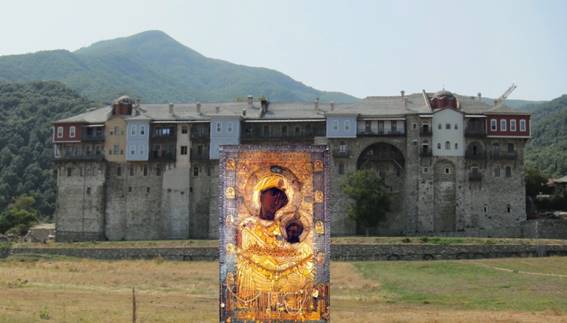
The Panagia Portaitissa, the famous miraculous 9th century icon of Virgin Mary, is also located at Iviron. The tradition of Mount Athos connects the icon with the period of Byzantine iconoclasm under the Emperor Theophilus (829–842).
In Nicaea, the solders of the emperor wanted to take the icon from one widow. The woman praying thrown the icon in the water, where it not sunk but stayed afloat and disappeared in horizon.
The only son of the widow became a monk, came to Mount Athos and spent his life in the monastery of Iviron. He told the story of the icon to his fellow monks. Once, years later after he had died, the icon appeared on the shore of the harbor of the monastery and was accepted by the humblest monk of Iviron.
The icon did not let the monks to put it in the Katholikon of the monastery, as every time it would disappear from there and would be found next to the gates of the monastery. Monks took it as a sign and a small chapel was built next to the gates and the icon of Panagia Portaitissa (“Gate-Keeper”) from that time until today can be found there.
An Arab pirate, who raided the monastery hit the icon with his knife and blood started flowing for the icon. The pirate became a Christian and a saint, he was named Aghios Varvaros (Saint Barbarian) and his painting can be found on the wall of the chapel.
Fontes:
Produzido por:

Consulte a Agenda do Museu a partir de 2025 e o visite quando receber sua confirmação de visita em seu email ou whatsapp.
Por se tratar de um museu particular, é necessário se cadastrar na Comunidade MuMi e customizar sua visita.
Criação e Tecnologia: Clayton Tenório @2025 MuMi – Museu Mítico